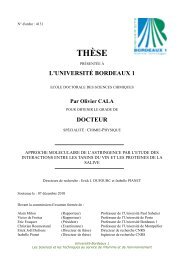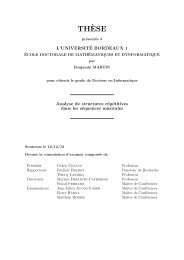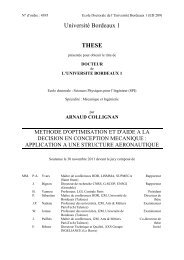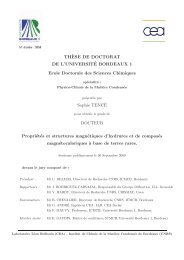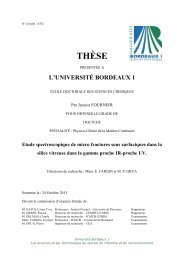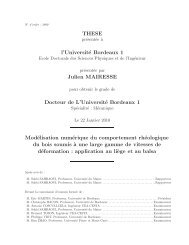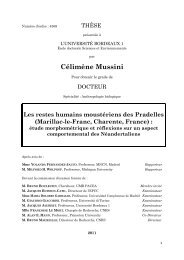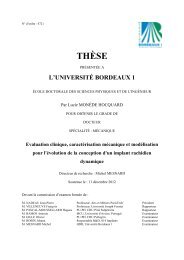de la structure à la croissance cellulaire - Université Bordeaux 1
de la structure à la croissance cellulaire - Université Bordeaux 1
de la structure à la croissance cellulaire - Université Bordeaux 1
Create successful ePaper yourself
Turn your PDF publications into a flip-book with our unique Google optimized e-Paper software.
102 M. Bourdon et al.<br />
their importance in human nutrition and their economic inference, fleshy fruit<br />
species have been the subject of <strong>de</strong>velopmental studies, mostly <strong>de</strong>voted to ovary<br />
formation, fruit set, and fruit maturation. The growth phase of the fruit has been<br />
much less addressed, although the complex interp<strong>la</strong>y between cell division and cell<br />
expansion during this period is a crucial <strong>de</strong>terminant of the final size, weight and<br />
shape of fruits. This chapter aims at reviewing our current knowledge on fleshy fruit<br />
<strong>de</strong>velopment and addresses the cellu<strong>la</strong>r and molecu<strong>la</strong>r mechanisms involved in<br />
their growth, with a special emphasis on the cell expansion associated process of<br />
endoreduplication, with tomato fruit as the mo<strong>de</strong>l species for fleshy fruits.<br />
1 Introduction<br />
The fruit is a p<strong>la</strong>nt organ specific to Angiosperms, which typically contains the<br />
seeds. At the botanical level, most fruits <strong>de</strong>velop from mature ovaries and, therefore,<br />
inclu<strong>de</strong> carpel tissues in part or whole. Additionally, many species <strong>de</strong>velop<br />
mature fruit tissues from extracarpel<strong>la</strong>ry floral components, e.g., strawberry, pineapple,<br />
mulberry, and pome fruits (apple, pear), in which the receptacle, bracts,<br />
calyx, and floral tube (the fused base of floral organs), respectively constitute the<br />
majority of mature fruit tissue (Coombe 1976; Gil<strong>la</strong>spy et al. 1993; Nitsch 1953).<br />
The fruit has evolved in Angiosperms to fulfill ovule and seed protection during<br />
embryo <strong>de</strong>velopment, and seed dispersal after maturation. This important physiological<br />
function accounts for a significant part of the adaptive success of Angiosperms.<br />
As such, the fruit has been un<strong>de</strong>r strong selective pressure, which accounts<br />
for the very wi<strong>de</strong> diversity of fruit size, form and composition, and of seed and fruit<br />
dispersion mechanisms. These mechanisms range from the small, non<strong>de</strong>hiscent<br />
akene dry fruit, dispersed by wind, to the <strong>la</strong>rge, fleshy, and juicy berry and drupe<br />
fruits, which have to be eaten by animals, such as mammals or birds for seed<br />
dispersion and germination. As an example, the So<strong>la</strong>naceae family, which encompasses<br />
nearly 10,000 species, has very diverse types of fruits, with capsules, drupes,<br />
pyrenes, berries, and several sorts of <strong>de</strong>hiscent noncapsu<strong>la</strong>r fruits occurring in more<br />
than 90 genera (Knapp 2002).<br />
According to common use, fruit refers to the fleshy, edible fruits, such as grape,<br />
banana, tomato, citrus, cucurbits, pomes, stone fruit, and mango. These species are<br />
subjected to major agricultural production, which rely on permanent selection and<br />
improvement in yield and quality. Their common feature is tissues that accumu<strong>la</strong>te<br />
water and many organic compounds, such as sugars, organic acids, pigments, f<strong>la</strong>vor<br />
and aromas, and vitamins, which bestow their juiciness and attractiveness. Most<br />
fundamental knowledge exists about the control of maturation of fleshy fruit<br />
(Giovannoni 2001, 2004), and their postharvest handling (Brecht et al. 2003;<br />
Soliva-Fortuny and Martin-Belloso 2003), and more recently, about the processes<br />
involved in carpel morphogenesis and fruit set by using the mo<strong>de</strong>l dry fruit of



